The BLM winter schedule has begun. It was requested that we put “everything” on one page as people are having difficulty tracking things that are happening. It is impossible to put everything on one page as there are dozens of moving parts and extensive history components that need to be understood in order to comprehend the current situations and then determine any course of action forward. But we hope this piece helps to stop some of the anxiety perpetuated by seeing “bits and pieces” that often get taken out of context.
Specifics of the current schedule in the section below “Background”
Background on the BLM program
Horses exist in multiple jurisdictions on land in the Continental US. When we discuss wild horses and burros people most often think of the Bureau of Land Management (BLM). (To read about other jurisdictions and wild horse slaughter go here: http://wildhorseeducation.org/2014/06/04/caught-in-a-tangled-web-the-reality-of-wild-horse-slaughter/)
In 1971 an act of Congress was passed to protect wild horses. There are many misconceptions about the document. This document essentially stopped the practice of “mustanging” (an unmanaged hunt for wild horses that was extremely brutal and decimating populations). This act gave jurisdiction to the federal government, and in it’s original form, made the sale of wild horses to slaughter a federally prohibited action. (links to some of the current underlying documents that effect wild horse management http://wildhorseeducation.org/essential-reading/blm-basis/)
The federal protection against slaughter was compromised with the Burn’s Amendment. (This action created the process of transference of “title” so that wild horses lost the status of “wild” and were again vulnerable to a legal sale to slaughter http://wildhorseeducation.org/burns-amendment/) Congress has repeatedly defunded the provisions of the act that allow federal funds to be used to kill healthy horses or send them to slaughter. (We do not know how this current Congress will vote on those provisions in the next round).
The “Burn’s Amendment” is not a range management document.
Range Management of wild horses under BLM jurisdiction can be as “clear as mud.” There are overlapping laws and a huge push for public land resource by uses that reap private profit. Those uses are governed under other sets of laws that often have Congressional mandates for prioritization. The prioritizing of those other uses often leaves field staff scrambling to meet those mandates while Congress fails to provide sufficient funding to appropriately address issues created by the prioritized uses. Wild horses and burros are severely impacted by this process and often become no more than a “footnote” in allotted budgetary needs (even though we often hear of just how much money the wild horse and burro program costs, the direct losses to the tax payer from the permitting process alone for public lang grazing (as an example) is twice the cost of the entire wild horse and burro program).

Tour being given to Velma Johnston, Wild Horse Annie, of the first capture of wild horses by the BLM
The first removal of wild horses under the act occurred in 1975 at Stone Cabin. This removal was no less controversial than those of today. However this removal should be looked at closely because it “set the stage.” Litigation created a court ruling that noted two important conclusions; BLM must comply with NEPA (http://wildhorseeducation.org/nepa/) and that the federal government could not simply remove wild horses to suit the needs of the livestock permittee. This removal also began the dialogue that led to the creation of the Wild Horse and Burro adoption program. Velma Johnston (Wild Horse Annie) was at the removal and actively involved. http://wildhorseeducation.org/2014/09/15/perspective-1975-first-blm-wild-horse-capture/
However the type of “footnote management” that has continued since that time has now led the BLM program to “fail” scientific scrutiny. The National Academy of Sciences (NAS) reviewed the program and created a report that was published in June of 2013 (available for download here: http://wildhorseeducation.org/2013/06/05/nas-report-a-first-look/ ). The National Academy of Sciences is considered one of the most credible scientific review entities in the world.
The report is currently under review and a series of policy recommendations that reflect the report should be published shortly. However as with many things “wild horse” we have heard this report misquoted and literally fictionalized by the livestock industry, BLM itself (including the state lead of CA completely misrepresenting what is in the report), and the advocate community. We highly suggest reading all components of the 400 page document and then taking time to understand each component as it pertains under existing law (all entities alike).
A very important factor to keep in mind as you see a schedule for wild horse and burro operations is the “big picture” of the current political, social and legal climate. Legal actions currently exist in three states with wild horses as the target of the livestock industry. There exists a current push by states and counties to “take over” management of federal resources, including wild horses. These efforts are not being made to “create protections” for wild horses, but to resume what many feel was “taken away” by the act, “mustanging.” (Mustanging allowed private entities to remove and sell to slaughter for profit). They are claiming a failure of the federal government to protect their ability to profit from public land grazing and are targeting horses, not their own over use of public land. (This article focuses on the state of Nevada http://wildhorseeducation.org/2014/09/03/editorial-nevada-showdown/)
Video from two years ago but still valid on policy (suggestion start at timecode: 2:01):
Hold Your Wild Horses! how did it get so bad? from Laura Leigh on Vimeo.
Current Schedule
The BLM schedule can be accessed here: http://www.blm.gov/wo/st/en/prog/whbprogram/herd_management/tentative_gather_schedule.html The word “tentative” is used because dates often change due to weather or other logistical factors. So no date on the schedule is “set in stone” until it actually happens.
There are several ongoing darting or trap and treat operations that are currently on the schedule. They include actions in the Pryor Mountains (MT) (better known as “Cloud’s herd), McCullough Peaks (WY), Spring Creek Basin (CO), Sand Wash Basin (CO), Caracas Basin (NM), Onaquai (UT) and Little Book Cliffs (CO). These operations are catch and treat only with no removals. Or are being implemented through darting. (At this time the BLM schedule has no “column” for darting operations.
Wild horses outside Piceance/East Douglas (CO) are in an ongoing trap and remove status that will remain legally active through the end of March.
Wild horses in the Antelope Complex (NV) in an area called “Wood Hills non HMA,” will be bait trapped and removed starting 2/1. This target is 130 wild horses.
Centennial (CA)
This is the first operation on the schedule. It began yesterday.
Centennial is located in southern CA. The operation targets both wild horses and burros. 35 burros are to be rounded up and removed. 215 wild horses are to be rounded up and the schedule says 35 removed and 100 treated with fertility control. There is NO BLM “gather update page” for updates on the operation. The operation is being conducted in conjunction with the US military base.
(As there are a number of advocates and orgs in CA we had expected to see reports coming from them on this. Due to our own budgetary limitations did not travel to this operation. We are preparing on the range documentation for the next one)
Humbolt (NV)
Humbolt is an HA, not an HMA. In other words the area was originally marked as having wild horse occupation in 1971 but was omitted from management for a wild horse population due to one (or more) of several factors. In this instance of Humbolt it was that the area was a “checkerboard” of public and private land. This map is a close up of the Humbolt HA http://www.blm.gov/pgdata/etc/medialib/blm/nv/field_offices/winnemucca_field_office/programs/wild_horse___burro/humboldt_herd_area.Par.8987.File.dat/HumboldtHA_springs_allotments%20(2).pdf
The current removal is due to letters from the private land owners and concern over the safety of people and motorists on a road that the wild horses in that area cross.
The BLM began removing wild horses from this area through bait trapping last year. (Slideshow of horses removed in holding from the Humbolt HA in 2014 http://wildhorseeducation.org/2014/06/27/humbolt-ha-bait-trap-holding-slideshow/)
This time the BLM will use a helicopter and the target is 180 horses. The horses will again be transported to the Palomino Valley Center (PVC) north of Reno for processing.
We were on the range with BLM staff this week for the official explanation and tour. We did note active use by wild horses, livestock, mining in the area. In several locations we noted extreme range degradation and evidence of extensive historic use by domestic livestock. We noted both condition and gps points and will investigate further.
We asked about the Comprehensive Animal Welfare Program (CAWP) and if the inclusion of the policy was finalized. We were told by the district manager for Winnemucca, Gene Seidlitz, that the operation would be done under the current “IM” for handling as he was not aware that any change in protocol was finalized (to see some of the fight we have actively engaged to get a policy in place go here: http://wildhorseeducation.org/whe-pledge/) Two of the court orders that address conduct issues were gained against removals in this district. However the wild horse and burros specialist that worked those removals is no loner in that district. We will update you from Humbolt.

Wild horse leaps to freedom after treatment with fertility control in 2010 on Thanksgiving Day in the Pine Nuts. The fertility control used at this operation should have been reapplied in 2012 to maintain any efficacy, it was not likely due to budget constraints.
Pine Nut (NV)
The current removal at the Pine Nuts is linked to an underlying document with no new “public comment” period being offered. We explain the Pine Nut and the justification process here: http://wildhorseeducation.org/2014/12/22/what-is-a-wild-horse-dna/ The Decision Record cites an “over AML” as the reason given.
This operation will round up 300 wild horses and remove 160. The intention is to treat 70 mares with fertility control and release the remaining captured wild horses.
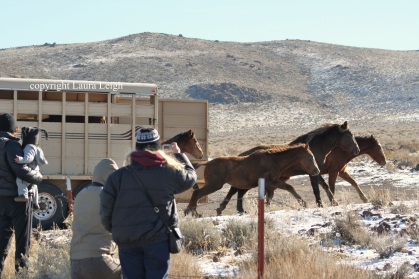
Thanksgiving Day release of Pine Nut horses in 2010 drew a crowd of locals. This herd has a strong local interest and is easily accessed in comparison to many other HMAs
There are multiple groups that are working with BLM on a darting program in the Fish Springs area of the Pine Nuts. It is our understanding that the horses in this area are not targeted for this operation. (More information as the date of the operation gets closer)
However the name “Fish Springs” has created some confusion. There are three areas that have the word “fish” in it for this winter schedule. The “Fish Springs” horses are part of the “Pine Nuts,” not a separate HMA.
Sulphur (UT)
This area in Utah targets 100 wild horses for removal. The operation likely will be a “BLM in house” scenario where the state team does the removal.
This area is part of another situation where political powder kegs exploded. Iron County became vocal during the “Bundy situation” and went on the attack against wild horses. http://wildhorseeducation.org/2014/04/10/wild-horses-targeted-today-in-iron-county-utah/ The push against federal authority in the state of Utah is strong and multifaceted http://wildhorseeducation.org/2014/09/19/utah-not-above-the-law/
Litigation has been filed against the wild horses and we are awaiting an update on that status from the groups involved http://www.reuters.com/article/2014/05/02/us-usa-utah-horses-idUSKBN0DI05A20140502

Multiple jurisdictions create special challenges. We have not gotten to LFL this year, (picture 2012)
Little Fish Lake (NV)
Little Fish Lake is one of the areas that are managed through multiple federal jurisdictions. After the Nevada Forest Enhancement Act of 1988, the U.S. Forest Service (FS) was transferred approximately 77,768 acres of the HMA to manage as a Wild Horse Territory (WHT) and the BLM retains 28,780 acres as the Little Fish Lake HMA.
The operation on the schedule deals with the BLM portion of Little Fish Lake. 150 will be rounded up and 100 removed. 25 mares will be treated with fertility control and released back to the range and the remaining 25 studs captured, will also be released.
This removal is tied to the underlying drought documents that can all be accessed here: https://www.blm.gov/epl-front-office/eplanning/projectSummary.do?methodName=renderDefaultProjectSummary&projectId=42837
These are the same documents used to restrict livestock in multiple areas. Restrictions in the Diamonds led to a retaliatory strike against wild horses by the Nevada Association of Counties (NACO) http://wildhorseeducation.org/?s=NACO. We are awaiting the courts ruling as to a decision on motions to dismiss to see if this case will move forward. Restrictions in areas where there are no wild horses led to the Grass March last year (however they also included wild horses in a political power play) http://wildhorseeducation.org/?s=Grass+March
Fish Creek (NV)
The removal number at Fish Creek is now listed in the schedule as 100 horses. The roundup itself will encompass a target of 500. An expected 150 mares will be treated with fertility control and ALL studs remaining over the removal number are to be released with no “sex skewing,” (a technique that makes an unproven claim of reducing birth rate).
This is the ONLY operation occurring this winter that requires a public comment to a new Environmental Assessment or EA.
Wild horse Education has been extremely active in this area for several years now.
We do a lengthy explanation of the process and ask that you sign our comment letter here: http://wildhorseeducation.org/2014/12/24/fish-creek-hma-public-comments-due-january-23/
Other alternatives in the document can be seen at the above link. One with no birth control would require the removal of about 1000 wild horses over the life of the EA and the one with no removals would require an additional 100 mares be treated with PZP just in the initial phase. There are comment letters on the web asking you to request these other alternatives. However please go to our link and read the section on commenting prior to choosing which alternative to support. Comments are NOT a voting process but are intended to point out areas where a lack of analysis or non compliance with laws exist toward furthering whatever you suggest.
Areas of process like the number of wild horses allowed on the range are NOT part of the EA. Those areas must be addressed in other areas of process and this EA does note that if changed through that process, will change in the final version of the EA.
Another area not covered under the EA is livestock management. That is addressed in another area of process. We are actively engaged in that area as well for these horses and this month the permittee was sent a bill for trespass cattle on the range. If the bill is not paid he will forfeit his right to graze on BLM land. This permittee has permits in other districts that could also face ramification from the trespass at Fish Creek. We are preparing to address any appeal that may be forthcoming from this permittee and will remain vigilant (we will write another story about that situation soon). PLEASE READ: http://wildhorseeducation.org/2015/01/09/nevada-rancher-gets-bill-for-livestock-trespass-in-wild-horse-area/
~~~
We hope that this fulfills the request and answers the multitude of questions we are receiving.
Wild Horse Education is on the range and engaged in dialogue NOW on many of the issues in this article. We need your support to continue this work. We are a small organization with no paid staff, corporate sponsorship or grants from larger organizations. http://WildHorseEducation.org/donate
Categories: BLM, Lead, Roundup Reality, Roundups, Wild Horse Education
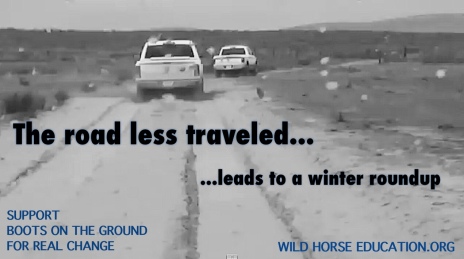
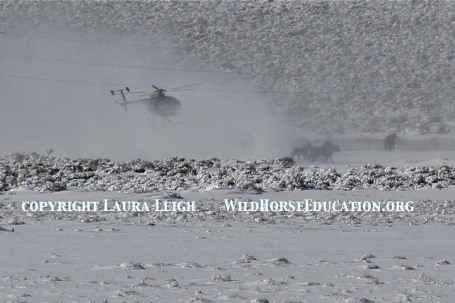


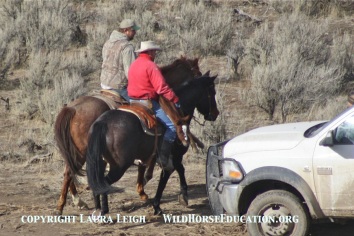


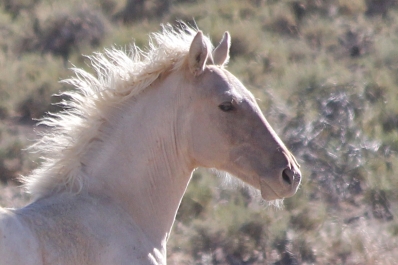


You must be logged in to post a comment.